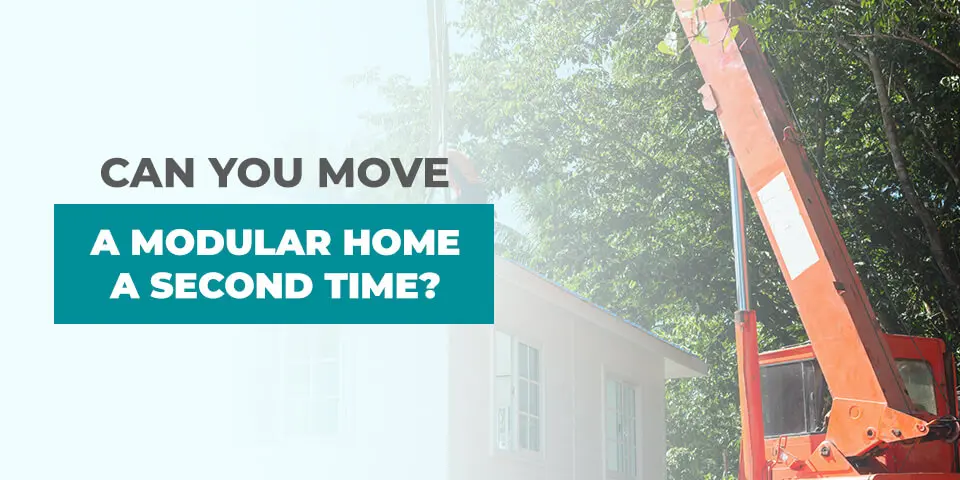
Modular homes consist of factory-built sections transported to a building site by trucks and joined together. While movers don’t do it often, moving a modular home a second time is possible. Learn more about modular home frames and foundations and how to move your property to another site.
Modular Home Frames and Types of Foundations
There are two main modular home frame options — on frame and off frame, with the frame referring to the steel skid the builder assembles the house on.
For off-frame modular homes, transportation carriers lift the structures from the frame by crane and place them on a permanent foundation. On-frame structures involve having the modular home left on its steel skid when installed.
Depending on the frame and location, your modular home can be placed on several foundation types:
- Pier: Anchor your modular home and protect it from floods and frost with cement cylinders set into the ground. Piers with steel straps attached provide a steel frame for your home with enclosed vinyl skirting.
- Slab: Add stability through winter’s freezing temperatures with support from an affordable 4- to 6-inch concrete slab foundation poured with sand or gravel. The slab provides a clean, dry area underneath your home for resistance to flooding, wind and frost. Combine piers underneath for the most supportive foundation possible.
- Slab and concrete block skirting: Create extra space for utilities and storage underneath your home with the popular stick-built aesthetic. Blocking stations under the steel beams of the house provide support, while the perimeter offers protection from pests and wind.
- Crawl space: Support the weight of your home while keeping it 48 inches off the ground. This foundation provides an average installation cost and resistance to humidity, wind, termites and frost.
- Basement: Add additional living space with a reliable foundation, windows and doors for your home using exact measurements and city building codes. At a higher cost, basement foundations increase your home’s square footage and value.
The 6 Steps of Moving a Modular Home to Another Site
Whether you’ve found your dream homestead or want to move to another location for work or closeness to family, moving modular homes allows for packing up everything and taking it with you. Relocating a structure involves uninstalling and moving modular parts. Prepare for your modular home move with these six steps:
- Prepare your building: Before your home transport, remove any breakable or heavy items and take loose items off the exterior walls. Moving insurance will cover your belongings if damage occurs.
- Unhook utilities: It’s best to hire a professional to remove gas and electricity connections safely and correctly. Ideally, your moving company will handle this step.
- Prepare the new location: Get the site ready before your home arrives. Choose from foundation options and follow local codes and regulations for building your structural site.
- Find the right moving company: Hire an experienced, reputable and qualified moving company. Choose a company with the proper permits and insurance for transport, preferably with utility unhooking services for an easier transition.
- Get an estimate: Check with your modular mover for an estimate. Factors affecting the cost include the type of foundation, local and state permits and the weight of the home.
- Plan your timing: Prepare for around two to three days for the uninstalling process. Travel time will vary based on distance, and installation with utility hookups at the new location generally takes a couple of weeks.
Moving a Modular Home FAQs
Plan for moving your modular home by reviewing these common questions and answers:
Can you move a prefab home?
Property owners can move a prefab home, although the costs may be high if the structure was intended to be permanent.
Can I move my modular home again?
Modular homes can move more than once, with the process being easier for on-frame homes since the steel skid helps with loading. When budgeting for a move, homeowners should consider factors like the size of the house, the transportation distance, conditions of the house and any related expenses noted by the mover.
How do you place a modular home permanently?
Obtaining an affidavit of affixture certifies the permanent placement on land and should be recorded at a county assessor or recorder’s office.
Smart building. Personalized spaces. Lasting comfort.
Design. Build. Modular is changing the homebuilding game across Connecticut, Massachusetts, and Rhode Island with a smarter, faster way to create beautiful custom homes. Using modern modular techniques, we help homeowners turn their vision into reality—with less stress and more style.
Each home we build is unique, shaped by your lifestyle, taste, and goals. With our tailored design process, you can personalize every detail—whether you’re beginning a new build or expanding your current residence.
Our team works closely with you to ensure your home reflects your personality. We offer various layout options, including luxury modular home plans, that can be adapted to your ideal aesthetic and space requirements.
To make planning easier, we provide Virtual Tours that let you explore the design and layout before anything is built. It’s a powerful way to understand how your home will look and feel in real life.
If you’re considering buying a modular home, our streamlined approach takes the guesswork out of the process. We walk you through every phase—from concept to completion—with full transparency and support.
Already have a home but need an upgrade? We also specialize in home renovation services and modular extensions that are efficient, elegant, and designed to complement your existing structure.
From cozy, personalized homes to grand, expansive modular mansions, we help you build a high end modular homes that delivers comfort, style, and lasting value.
